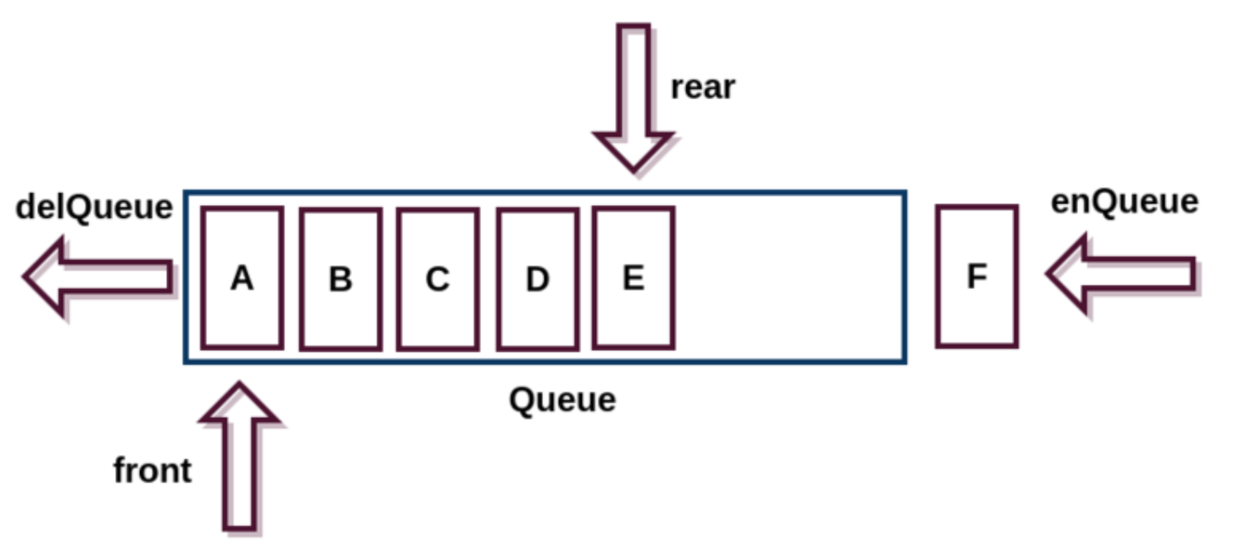一.认识队列
队列(Queue)
- 它是一种运算受限的线性表,先进先出(FIFO First In First Out)
- 队列是一种受限的线性结构
- 受限之处在于它只允许在表的前端(front)进行删除操作,而在表的后端(rear)进行插入操作
生活中类似于栈的结构的事情有很多, 比如在电影院, 商场, 甚至是厕所排队.

程序中怎么实现的呢?
- 在进行多线程开发时, 我们不可能无限制的开启新的线程.
- 这个时候, 如果有需要开启线程处理任务的情况, 我们就会使用线程队列.
- 线程队列会依照次序来启动线程, 并且处理对应的任务.
二.队列结构实现(js版)
我们先来创建一个队列的类, 用于封装队列相关的操作
// 封装队列 先进后去function Queue() {//属性this.items = []// 方法// 1 将元素加入队列Queue.prototype.enqueue = function (element) {this.items.push(element)}// 2 从队列中删除前段元素Queue.prototype.dequeue = function (element) {return this.items.shift()}// 3 查看前端元素Queue.prototype.front = function (element) {return this.items[0]}// 4 查看队列是否为空Queue.prototype.isEmpty = function (element) {return this.items.length === 0}// 5 查看列队中元素的个数Queue.prototype.size = function (element) {return this.items.length}// 6 toString 方法Queue.prototype.toString = function (element) {var resultString = ''for (let i = 0; i < this.items.length; i++) {resultString += this.items[i]}return resultString}}// 使用队列var queue = new Queue()
队列的操作
列队常见有哪些操作呢?
在普通的队列插入一个元素, 数据会被放在后端. 并且需要前面所有的元素都处理完成后才会处理前面的数据.
- 但是优先级队列, 在插入一个元素的时候会考虑该数据的优先级.(和其他数据优先级进行比较)
- 比较完成后, 可以得出这个元素正确的队列中的位置. 其他处理方式, 和队列的处理方式一样.
- 也就是说, 如果我们要实现优先级队列, 最主要是要修改添加方法. (当然, 还需要以某种方式来保存元素的优先级)
优先级队列应用也非常广泛
- 另一个现实中的例子是医院的(急诊科)候诊室。
- 医生会优先处理病情比较严重的患者。
- 计算机中, 我们也可以通过优先级队列来重新排序队列中任务的顺序
// 优先级队列function PriorQueue() {// 封装属性this.items = []// 二次继承function QueueElement(element, proiorty) {this.element = elementthis.proiorty = proiorty}PriorQueue.prototype.enqueue = function (element, proiorty) {// 创建QueueElement对象var queueElement = new QueueElement(element, proiorty)if (this.items.length === 0) {this.items.push(queueElement)} else {var add = falsefor (let i = 0; i < this.items.length; i++) {if (queueElement.proiorty < this.items[i].proiorty) {this.items.splice(i, 0, queueElement)add = true}}if (!add) {this.items.push(queueElement)}}}PriorQueue.prototype.toString = function (element) {var resultString = ''for (let i = 0; i < this.items.length; i++) {resultString += this.items[i].element + this.items[i].proiorty}return resultString}}// 使用var pd = new PriorQueue()

